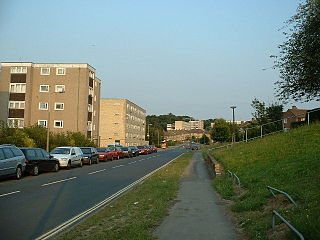
Southampton, Itchen is a constituency represented in the House of Commons of the UK Parliament since 2015 by Royston Smith, a Conservative member of parliament. Discounting the Speaker returned in the early 1970s in two elections, local voters have elected the MP from only two parties alternately for various periods, with one party reaffiliation (defection) between elections when the Labour Party split in the 1980s.

Saint Anne's Park is a 240 acres (97 ha) public park situated between Raheny and Clontarf, suburbs on the northside of Dublin, Ireland. It is owned and managed by Dublin City Council.

Portswood is a suburb and Electoral Ward of Southampton, England. The suburb lies to the north-north-east of the city centre and is bounded by Freemantle, Highfield, Swaythling, St. Denys and Bevois Valley.

Freemantle is a suburb and electoral ward in Southampton, England.

Bitterne is an eastern suburb and ward of Southampton, England.

Townhill Park is a suburb of Southampton, England, bordering Swaythling, Bitterne Park and West End. It is built on land which once belonged to the house which carries the same name.

Bitterne Manor is a suburb of Southampton surrounding the manor house of the same name. It is located on the eastern bank of the River Itchen, across Cobden Bridge from St Denys.

Bitterne Park is a suburb and Electoral Ward of Southampton, England, on the Eastern bank of the River Itchen, built on sloping parkland which once formed part of Bitterne Manor.

Moor Park is a Neo-Palladian mansion set within several hundred acres of parkland to the south-east of Rickmansworth in Hertfordshire, England. It is called Moor Park Mansion because it is in the old park of the Manor of More. It now serves as the clubhouse of Moor Park Golf Club.

Sholing, previously Scholing, is a district on the eastern side of the city of Southampton in Southern England. It is located between the districts of Bitterne, Thornhill and Woolston.

Bassett is a suburb and electoral ward of the City of Southampton, England. The suburb lies to the north of the city centre and is largely residential, including the University of Southampton's Glen Eyre Halls of residence complex, which houses around 2,100 students. Bassett gives its name to part of the A33 arterial road which links the city centre to the M3, described by Pevsner & Lloyd as "part of the splendid tree-lined route into Southampton from Winchester, London and the north". The highest point in the City of Southampton lies on Bassett Avenue at a height of 82 metres (269 ft) above sea level.
Southampton was a parliamentary constituency which was represented in the British House of Commons. Centred on the town of Southampton, it returned two members of parliament (MPs) from 1295 until it was abolished for the 1950 general election.
Southampton is a city in Hampshire, England. The area has been settled since the Stone Age. Its history has been affected by its geographical location, on a major estuary on the English Channel coast with an unusual double high-tide, and by its proximity to Winchester and London; the ancient and modern capitals of England. Having been an important regional centre for centuries, Southampton was awarded city status by Queen Elizabeth II in 1964 .

Southampton Corporation Tramways were in operation from 1879 to 1949. They were initially horse-drawn, but latterly powered by electricity.

Clausentum was a small town in the Roman province of Britannia. The site is believed to be located in Bitterne Manor, which is now a suburb of Southampton.
South Stoneham was a manor in South Stoneham parish. It was also a hundred, Poor law union, sanitary district then rural district covering a larger area of south Hampshire, England close to Southampton.

Townhill Park House is a Grade II listed former manor house between the neighbouring housing estates of Townhill Park in Southampton and Chartwell Green in Eastleigh.

Southampton Corporation Transport motor bus services started in 1919 as a successor to Southampton Corporation Tramways. After Southampton achieved city status in 1964 it was renamed Southampton City Transport. In 1986, as a result of deregulation it became Southampton Citybus, an arms-length company that was sold to the staff in 1993. It continued trading as Southampton Citybus until it was bought by First Bus in 1997.
Royston Matthew Smith is a British Conservative Party politician and has served as Member of Parliament (MP) for Southampton Itchen since the 2015 general election. Smith was previously a councillor on the Southampton City Council.
James Barlow Hoy, also styled James Barlow-Hoy was an Irish-born military surgeon and politician who represented the Southampton constituency in the British parliament and also served as Deputy Lieutenant Sheriff of Southampton.


















